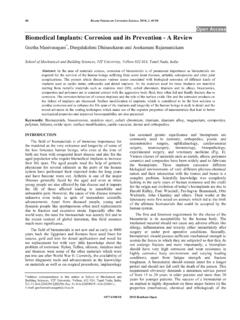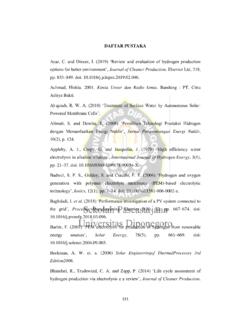Transcription of Sulfide Stress Cracking --NACE MR0175-2002, …
1 Sulfide Stress Cracking --NACE mr0175 -2002, mr0175 /ISO 15156650Te c h n i c a lThe Details NACE mr0175 , Sulfide Stress Corrosion Cracking Resistant Metallic Materials for Oil Field Equipment is widely used throughout the world. In late 2003, it became NACE mr0175 /ISO 15156, Petroleum and Natural Gas Industries - Materials for Use in H2S-Containing Environments in Oil and Gas Production. These standards specify the proper materials, heat treat conditions and strength levels required to provide good service life in sour gas and oil International (formerly the National Association of Corrosion Engineers) is a worldwide technical organization which studies various aspects of corrosion and the damage that may result in refineries, chemical plants, water systems and other types of industrial equipment. mr0175 was first issued in 1975, but the origin of the document dates to 1959 when a group of engineers in Western Canada pooled their experience in successful handling of sour gas.
2 The group organized as a NACE committee and in 1963 issued specification 1B163, Recommendations of Materials for Sour Service. In 1965, NACE organized a nationwide committee, which issued 1F166 in 1966 and mr0175 in 1975. Revisions were issued on an annual basis as new materials and processes were added. Revisions had to receive unanimous approval from the responsible NACE the mid-1990 s, the European Federation of Corrosion (EFC) issued 2 reports closely related to mr0175 ; Publication 16, Guidelines on Materials Requirements for Carbon and Low Alloy Steels for H2S-Containing Environments in Oil and Gas Production and Publication 17, Corrosion Resistant Alloys for Oil and Gas Production: Guidance on General Requirements and Test Methods for H2S Service. EFC is located in London, International Organization for Standardization (ISO) is a worldwide federation of national standards bodies from more than 140 countries.
3 One organization from each country acts as the representative for all organizations in that country. The American National Standards Institute (ANSI) is the USA representative in ISO. Technical Committee 67, Materials, Equipment and Offshore Structures for Petroleum, Petrochemical and Natural Gas Industries, requested that NACE blend the different sour service documents into a single global task was completed in late 2003 and the document was issued as ISO standard, NACE mr0175 /ISO 15156. It is now maintained by ISO/TC 67, Work Group 7, a 12-member Maintenance Panel and a 40-member Oversight Committee under combined NACE/ISO control. The three committees are an international group of users, manufacturers and service providers. Membership is approved by NACE and ISO based on technical knowledge and experience. Terms are limited. Previously, some members on the NACE Task Group had served for over 25 mr0175 /ISO 15156 is published in 3 volumes.
4 Part 1: General Principles for Selection of Cracking -Resistant MaterialsPart 2: Cracking -Resistant Carbon and Low Alloy Steels, and the Use of Cast IronsPart 3: Cracking -Resistant CRA s (Corrosion-Resistant Alloys) and Other AlloysNACE mr0175 /ISO 15156 applies only to petroleum production, drilling, gathering and flow line equipment and field processing facilities to be used in H2S bearing hydrocarbon service. In the past, mr0175 only addressed Sulfide Stress Cracking (SSC). In NACE mr0175 /ISO 15156, however, but both SSC and chloride Stress corrosion Cracking (SCC) are considered. While clearly intended to be used only for oil field equipment, industry has applied mr0175 in to many other areas including refineries, LNG plants, pipelines and natural gas systems. The judicious use of the document in these applications is constructive and can help prevent SSC failures wherever H2S is present.
5 Saltwater wells and saltwater handling facilities are not covered by NACE mr0175 /ISO 15156. These are covered by NACE Standard RP0475, Selection of Metallic Materials to Be Used in All Phases of Water Handling for Injection into Oil-Bearing Formations. When new restrictions are placed on materials in NACE mr0175 /ISO 15156 or when materials are deleted from this standard, materials in use at that time are in compliance. This includes materials listed in mr0175 -2002, but not listed in NACE mr0175 /ISO 15156. However, if this equipment is moved to a different location and exposed to different conditions, the materials must be listed in the current revision. Alternatively, successful use of materials outside the limitations of NACE mr0175 /ISO 15156 may be perpetuated by qualification testing per the standard. The user may replace materials in kind for existing wells or for new wells within a given field if the environmental conditions of the field have not Stress Cracking --NACE mr0175 -2002, mr0175 /ISO 15156651Te c h n i c a lNew Sulfide Stress Cracking Standard for RefineriesDon Bush, Principal Engineer - Materials, at Emerson Process Management Fisher Valves, is a member and former chair of a NACE task group that has written a document for refinery applications, NACE MR0103.
6 The title is Materials Resistant to Sulfide Stress Cracking in Corrosive Petroleum Refining Environments. The requirements of this standard are very similar to the pre-2003 mr0175 for many materials. When applying this standard, there are changes to certain key materials compared with NACE mr0175 -2002. ResponsibilityIt has always been the responsibility of the end user to determine the operating conditions and to specify when NACE mr0175 applies. This is now emphasized more strongly than ever in NACE mr0175 /ISO 15156. The manufacturer is responsible for meeting the metallurgical requirements of NACE mr0175 /ISO 15156. It is the end user s responsibility to ensure that a material will be satisfactory in the intended environment. Some of the operating conditions which must be considered include pressure, temperature, corrosiveness, fluid properties, etc. When bolting components are selected, the pressure rating of flanges could be affected.
7 It is always the responsibility of the equipment user to convey the environmental conditions to the equipment supplier, particularly if the equipment will be used in sour various sections of NACE mr0175 /ISO 15156 cover the commonly available forms of materials and alloy systems. The requirements for heat treatment, hardness levels, conditions of mechanical work and post-weld heat treatment are addressed for each form of material. Fabrication techniques, bolting, platings and coatings are also of NACE mr0175 /ISO 15156 Low concentrations of H2S (< psi (0,3 kPa) H2S partial pressure) and low pressures (<65 psia or 450 kPa) are considered outside the scope of NACE mr0175 /ISO 15156. The low Stress levels at low pressures or the inhibitive effects of oil may give satisfactory performance with standard commercial equipment. Many users, however, have elected to take a conservative approach and specify compliance to either NACE mr0175 or NACE mr0175 /ISO 15156 any time a measurable amount of H2S is present.
8 The decision to follow these specifications must be made by the user based on economic impact, the safety aspects should a failure occur and past field experience. Legislation can impact the decision as well. Such jurisdictions include; the Texas Railroad Commission and the Minerals Management Service (offshore). The Alberta, Canada Energy Conservation Board recommends use of the of Sulfide Stress Cracking (SSC) and Stress Corrosion Cracking (SCC)SSC and SCC are Cracking processes that develop in the presence of water, corrosion and surface tensile Stress . It is a progressive type of failure that produces Cracking at Stress levels that are well below the material s tensile strength. The break or fracture appears brittle, with no localized yielding, plastic deformation or elongation. Rather than a single crack, a network of fine, feathery, branched cracks will form (see Figure 1). Pitting is frequently seen, and will serve as a Stress concentrator to initiate SSC, hydrogen ions are a product of the corrosion process (Figure 2).
9 These ions pick up electrons from the base material producing hydrogen atoms. At that point, two hydrogen atoms may combine to form a hydrogen molecule. Most molecules will eventually collect, form hydrogen bubbles and float away harmlessly. However, some percentage of the hydrogen atoms will diffuse into the base metal and embrittle the crystalline structure. When a certain critical concentration of hydrogen is reached and combined with a tensile Stress exceeding a threshold level, SSC will occur. H2S does not actively participate in the SSC reaction; however, sulfides act to promote the entry of the hydrogen atoms into the base little as psi (0,3 kPa) H2S partial pressure in 65 psia (450 kPa) hydrocarbon gas can cause SSC of carbon and low alloy steels. Sulfide Stress Cracking is most severe at ambient temperature, particularly in the range of 20 to 120 F (-6 to 49 C). Below 20 F (-6 C) the diffusion rate of the hydrogen is Figure 1.
10 Photomicrograph Showing Stress Corrosion CrackingSulfide Stress Cracking --NACE mr0175 -2002, mr0175 /ISO 15156652Te c h n i c a lso slow that the critical concentration is never reached. Above 120 F (49 C), the diffusion rate is so fast that the hydrogen atoms pass through the material in such a rapid manner that the critical concentration is not reached. Chloride SCC is widely encountered and has been extensively studied. Much is still unknown, however, about its mechanism. One theory says that hydrogen, generated by the corrosion process, diffuses into the base metal in the atomic form and embrittles the lattice structure. A second, more widely accepted theory proposes an electrochemical mechanism. stainless steels are covered with a protective, chromium oxide film. The chloride ions rupture the film at weak spots, resulting in anodic (bare) and cathodic (film covered) sites. The galvanic cell produces accelerated attack at the anodic sites, which when combined with tensile stresses produces Cracking .












